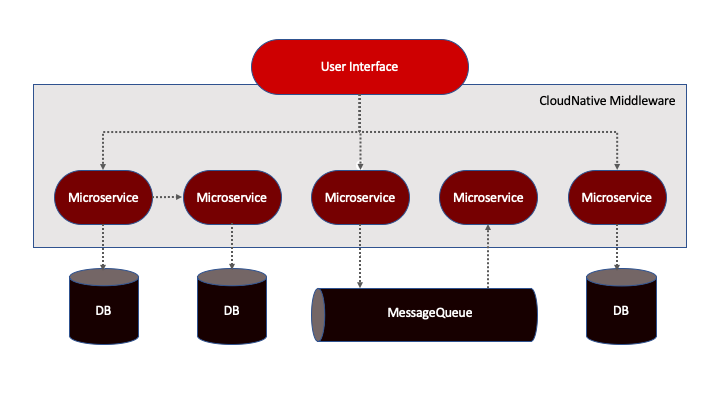In this article, we cover some of the most important aspects of developing and running cloud-native software, as well as what to take care about before going cloud-native. We’ll also delve into cloud-native architectures, technologies, development, and discuss the advantages of cloud-native software in general. Lastly, we’ll look at the change in mindset required for adopting cloud-native solutions.
Cloud-native software is a rapidly growing trend in the world of software development, and for good reason. This approach to building and running software is optimized for cloud computing environments and offers a number of benefits that can help businesses of all sizes and types to compete in today‘s digital economy.

What is cloud-native software?
But before we dive deeper into the world of cloud-native software, let’s discuss what cloud-native software is: A cloud-native application built on a cloud-native architecture, running on cloud-native infrastructures.
Cloud-native infrastructures are infrastructures meant to be breathing. This is a fundamental difference compared to traditional, static infrastructures. These infrastructures were designed to be there, to remain stable, to have a defined sizing. In comparison, cloud-native infrastructures are laid out to be volatile and adoptable: When there is more demand, more infrastructure will be provisioned dynamically. When there is a new version of an application, it will be rolled out on dynamically provisioned infrastructure. When demand slows down, infrastructure will be deprovisioned. The infrastructure adopts to the requirements of the workloads running on top of it.
The cloud-native architecture enables the application to be deployed in such a dynamic, potentially even distributed, environment. These environments can be public or private clouds, or a mixture of them (hybrid- or multi-clouds). The architecture is designed to be modular, scalable, and resilient, allowing applications built upon it to be deployed on any cloud platform.
Cloud-native applications itself are designed to be distributed and decoupled, which allows them to be deployed across multiple nodes in a cloud environment. This enables scalability and portability, preventing from vendor locks. Additionally, cloud-native applications are designed to be fault tolerant, meaning they can continue to serve requests even in the event of a node failure.
Cloud-native applications are designed from ground up to take advantage of the capabilities of the cloud environment. This includes support for auto-scaling, which allows applications to automatically and dynamically scale up and down in response to customer demand. It also includes support for auto-healing, which allows applications to detect and repair any errors that occur in the system.
Advantages of cloud-native software
One of the key advantages of cloud-native software is its ability to scale up or down as needed to meet changing business demands. With traditional software, businesses often have to invest in expensive hardware and infrastructure to support new users or services. But with cloud-native software based upon cloud-native architectures, running on cloud-native infrastructures, businesses can easily and quickly add more resources as needed, without having to make significant upfront investments. This means that businesses can be more responsive to changing market conditions and customer needs and can better compete overall.
Flexibility
Another benefit of cloud-native software is its flexibility. Because it is designed to run in a cloud environment, it can be easily deployed across multiple locations and devices. This allows to take advantage of the global reach of the cloud to have workloads being available at locations where their customers reside.
It also means that businesses can more easily adapt to changing market conditions or political changes, as they can quickly and easily move their workloads. Or businesses can decide to have the application on infrastructure being controlled by them, in their own private cloud environments. Without having to change the application itself.
Cost-Efficiency
In addition, cloud-native software can also be more cost-efficient than traditional software, since they typically can be rolled out with a smaller footprint than traditional software. When the load increases, new infrastructures and resources can be provisioned – but other than with traditional software on traditional environments, this can happen when it is needed, not upfront. This aspect can be especially beneficial for small and medium-sized businesses, which often have limited budgets and resources.
Open Source based
One of the biggest issues with traditional software is that is often based on closed source components or vendor specific infrastructures. Think of software required to run on a specific operating system, such as Windows, working best only with the database server from the same vendor (SQL Server). Even before serving a single customer, business have to handle huge upfront payments, or when they choose a subscription-based model, high monthly fees.
Cloud-native software is built upon an entirely different ecosystem. Here, most, if not all, components of infrastructure and middleware stacks would be based upon open source software. Businesses would be able to choose the point in time when they want to pay the vendor – for support, or managed services, or maintenance, but not for licenses, as it is the case with traditional closed source software. Typically, open source-based infrastructures are way more inexpensive then their closed source counterparts, which increasingly often are based upon open source components themselves.
And don’t forget about the inherent security aspect associated with open source software: since the software is open source, everyone can have a look at it and identify security issues. This transparency leads to bugs and issues most often being fixed way faster than with closed source software.
By using open source software as basis for cloud-native applications and infrastructures, businesses can avoid vendor-lock, meaning they can avoid being tied to a specific vendor‘s product on a specific vendor’s infrastructure or platform. This gives more freedom to change providers or software options if needed.

Fig. 1: Agile and DevOps-oriented culture that is focused on rapid iteration and continuous delivery
Cloud-native software embraces (and enforces) Change
However, to fully take advantage of the benefits of cloud-native software, organizations will need to change their mindset and approach to software development and operations, such as adopting a more agile and DevOps-oriented culture that is focused on rapid iteration and continuous delivery (fig. 1). It also implies investing in the right tools and practices to manage and monitor cloud environments, and to automate as many processes as possible.
Change in operations
In terms of operations, teams will need to be equipped to handle the dynamic nature of cloud environments, with a focus on monitoring and automation. This will require a shift away from traditional, manual processes towards more automated and cloud-native tools and practices. Operations teams need to learn about automation, about tools such as Ansible, Terraform and GIT. They will need to overcome their traditional approaches of doings things by hand – everything needs to be automated; everything needs to be executed based on versioned scripts. This is a huge change in approach and mindset.
The operations processes themselves need to be adopted as well, in fact, they need to be rethought entirely: Since cloud-native software is modular and decoupled, and since cloud-native infrastructures are based on the concept of volatility, traditional operations approaches don’t fit anymore. Operations does need to become proactive, not reactive as it was in the past. And since the sheer number of components being involved can be way bigger than within traditional environments, approaches such as Centralized Metrics and Centralized Logging need to build the foundation of an operational environments.
Which then in turn requires deeper and better integration with development teams, to ensure proper exposure of metrics and logs to the underlying platform. This means promoting collaboration and communication across teams and encouraging experimentation and learning.
It also means fostering a culture of continuous improvement and encouraging employees to embrace new technologies and ways of working.
And it also have to include adopting the right security measures to protect data and applications in the cloud and to ensure compliance with relevant regulations. This alone would be the topic for its own article and conversation.

Change in Architecture and Development
When it comes to software development, cloud-native software requires a different approach than traditional software development. Instead of monolithic architectures, cloud-native applications are built using microservices, which are small, independently deployable services, running inside containers, communicating with each other over APIs and Message Queues (fig. 2 and 3).
This allows for faster development and deployment cycles, and makes it easier to scale and update individual components of the application. But it comes with a cost: More services imply more complexity on the infrastructural level. More services also imply more chances of things breaking. And it implies more challenges when rolling things out or updating components.
This then in turn leads to not only technical-, but also mindset-based changes: To handle these complexities and challenges, services need to be written more resiliently, with a mindset of embracing the ever-changing nature of cloud environments. New frameworks and tools have to be learned, error-handling has to happen differently and more intensively, metrics and logs need to be exposed, deployment processes need to be automated end-to-end, and everything needs to be configurable from the outside world. Finally, softer and often underrated aspects of a developments cycle, such as documentation of components, need to be improved upon as well.
Change in Culture
Since cloud-native environments and software imply a multitude of technical changes, the culture within an organization needs to change as well: away from the error-preventing and static thinking of the past, embracing change and fostering a climate of error-management. Errors will happen, in fact, they should happen, since we only master complexity by knowledge and experience, which can only be gained from handling errors as well as successes.
Also, as already pointed out, communication and crossteam interaction need to change a lot: since the complexity of cloud-native applications is different on all levels when compared with traditional applications, communication and interaction need to happen constantly. Limiting conversations to silos and preventing holistic approaches, would be a fundamental flaw, leading to huge challenges in operations, development, security, and longevity of infrastructures and applications. Constant change and iterations need to be the center of culture in an organization working with and within cloud-native environments, not standstill or egoistic approaches.

Fig. 3: Microservices, which are small, independently deployable services, running inside containers, communicating with each other over APIs and Message Queues
Closing thoughts
Overall, cloud-native software can bring significant benefits to businesses and organizations, including technical capability such as increased scalability, flexibility, cost-efficiency and the benefits of open source software and avoidance vendor-locks. But to fully realize these benefits, businesses will need to change their mindset and approach to software development, operations, and interaction, adopting a more agile and DevOps-oriented culture.
This will require investing in the right tools and practices and encouraging collaboration and experimentation across teams. By embracing cloud-native software, businesses can be more responsive to changing market conditions, more cost-efficient, and better compete in today‘s fast-paced digital economy.
Which will turn into a huge benefit not only technically or culturally, but also financially and regarding long-time sustainability of a business.

Karsten Samaschke
Founder and CEO of Cloudical
karsten.samachke@cloudical.io
